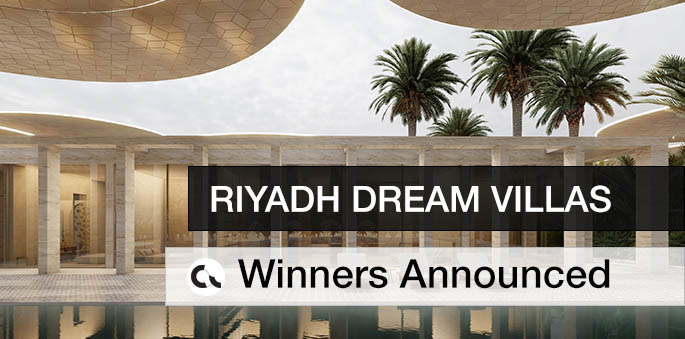The call for ideas RIYADH DREAM VILLAS was launched in December 2021 by YAC – Young Architects Competitions – in collaboration with Jarir Development with the goal of designing two different villas at the borders of Riyadh.
Disputed between artificial space and natural landscape, the villa has always been an extraordinarily effective architectural archetype. It has always stood for the most noble concept of dwelling and often materialized the dream house of those who have to give shape to it.
Luxury, post-pandemic aspirations and breath-taking landscape are just some of the pillars of Riyadh Dream Villas. Such competition will invite architects to write a new chapter of living at the edge of Riyadh’s desert by designing two immeasurably valuable architectural interventions. Moreover, they will give their contribution to the ongoing and constant transformation of the most essential architectural typology: the dwelling.
Designers from more than 100 countries took part in this compelling challenge proposing their valuable concept ideas evaluated by an outstanding jury panel including Sou Fujimoto, Nicola Scaranaro (Foster + Partners), Benedetta Tagliabue, Ben van Berkel (UNStudio), Lorendo Boddi (BIG – Bjarke Ingels Group), Eli Synnevåg (Snøhetta), Abdulsalam Al-Agil and Ammar Atfah from Jarir Company. The jury members evaluated the project proposals selecting those better responding to the competition’s brief. The winning projects have been awarded with a total cash prize of €25,000 distributed to the first five teams ranking.
Winners

In particular, the team Daffonchio Architects from South Africa ranked first and was rewarded with € 10,000. The project designed by Enrico Maria Daffonchio, Ayesha Cachalia and Robert Dos Santos is “ centered around the idea of forming a microclimate for the Villas through a strong aesthetic concept. The delicate spatial blocks are surrounded by a forest of kinetic canopies. These ‘living ‘eccentric elements are powered by & are reactive to the sun. The canopies automatically rotate & adjust in elevation to regulate the seasonal temperatures & sun conditions. They will shelter the walkways & outdoor spaces from rain while collecting the water. At night, the canopies open up to reveal dramatic, framed views of the night sky. The architectural language is layered with elements that introduce the concept of ‘transitional spaces’, which are neither internal nor external. One will walk through carefully crafted spaces, surrounded by landscape, art & references to traditional Arabic architecture. These elements intentionally frame specific lines of sight while blocking off others, creating spaces of privacy, beauty & contemplation.”

The second prize of € 6,000 was awarded to the team .1 Lab from Hong Kong featuring Man Kit Cheung and Chau Kit Yip whose project named “Hidden Oasis draws an idea of a luxury settlement with water and vegetation by camouflage to match the historical soil and rock in Riyadh, Saudi Arabia. The masks are the subject that form seclusion and cultural response. The surface, as like the sandstone hill with matching colour, fully encloses the settlement profiles in order to minimize visual impact to the scene of the desert. The functional volumes are formed by the typical form of space in the reference of Arabic culture. Organic form with rigid arrangement draws an intent of integration between the natural power and the artificial force. The columns are equally distributed on site to hidden the buildings themselves and the artificial landscape in order to reduce the impact from the harsh conditions of the outer environments in the desert. Each of the column are also the rainwater collector for the purpose of storing portable water”

The team NEODIGMA from UK gathering Zekun Qin, Yolande Wang, Peiyao Yu and Weiqi Xie was rewarded with a third prize of € 4,000. Their proposal focused on the wall as “a pure, mathematical vector – is the fundamental element of architecture. lt is the primary language of shelter against natural hazards. lt is the boundary with which dignified Iife is established. lt is the manifestation of human order within the wilderness. The Arabian desert climate – dry wind, sandstorms, heat under the sun, cold in the night – calls for direct response in an architectural form that cleverly manoeuvres the transfer of heat Therefore, the design of the two villas is a series of parallel walls constructed with concrete, following a grid for each villa. As a result, the walls has become the tool for carrying out domestic life – from common space family activities to entertaining private guests, the most simple element of architecture enables I ife to flourish, between the walls.”
Two Gold Mentions rewarded with € 2.500 each follow in the ranking: the Italian team NEODIGMA made by Stefano Vitale and Ludovica Marconi and the team Whitespace Design from UK featuring Utkan Yonter and Sara Ayse Olmez.

For the first one, team NEODIGMA, “the key idea behind the project is to use extreme climatic conditions – such as wind and radiation heat – to generate a natural passive ventilation system that cools the rooms below. The shape of the roof is optimized to maximize the Coanda effect and draw warm air from inside through air chimneys. This is made possible thanks to the difference in pressure between the volume of air on the surface and the underground channels. The combination of this bioclimatic system and the model of the patio house – typical of the Arab tradition – creates an adaptive system that we believe will be able to respond to both the climatic and cultural needs of the two villas. Indeed, the patios not only protect from direct sunlight, but also emphasize the culture of privacy, while also enriching the villas with small oases, orchards and gardens that contrast with the emptiness and dryness of the desert.”

The second one, team Whitespace Design, was “inspired by traditional connected courtyards and narrow streetscapes: both villas form a labyrinth, with intertwined open and enclosed spaces. Using a grid layout, each main cluster of spaces for specific users is placed around a central courtyard. The hierarchy of the courtyards reflects its users; for example, the largest is placed within the main residence cluster. All courtyards are open to the sky and surrounded by a circulation belt that is semi-enclosed, providing the luxurious feel of outdoor and indoor living simultaneously. The aim of this spatial design is to allow for fluidity in use. On the one hand, reflecting the local culture and traditional cohabitation of several generations from one family, the villas offer separate areas to accommodate each group. On the other, considering that with the passage of time some traditions are subject to change or adaptation, each separate cluster also reconnects to form a nuclear family home. The flexibility and seamless flow through these spaces are made possible through the use of a network of corridors. The corridors, open or covered, also guide the user to framed views and curated outdoor spaces. The garden was imagined as an oasis, designed on a grid, and woven like a tapestry of different elements: desert, greener blocs of local flora and fauna, water, decking…. One of the benefits of creating a labyrinth of spaces is that there will be always unique and dedicated spaces for users’ specific needs: quiet nooks, playgrounds, private loggias, cacti gardens and decked outdoor dining areas… The choice of local coral stone, palm wood and blocks of sand wall, besides providing cost-friendly solutions, ensure that the villas will withstand the harsh weather conditions of the region. By respecting the stunning beauty of local materials, colours and vegetation, the villas blend seamlessly into their surroundings, and with this timeless design approach that references local heritage, the villas can be adapted easily by their users today and in the future.”
Honorable Mentions












All the projects are available on YAC’s website: www.youngarchitectscompetitions.com








